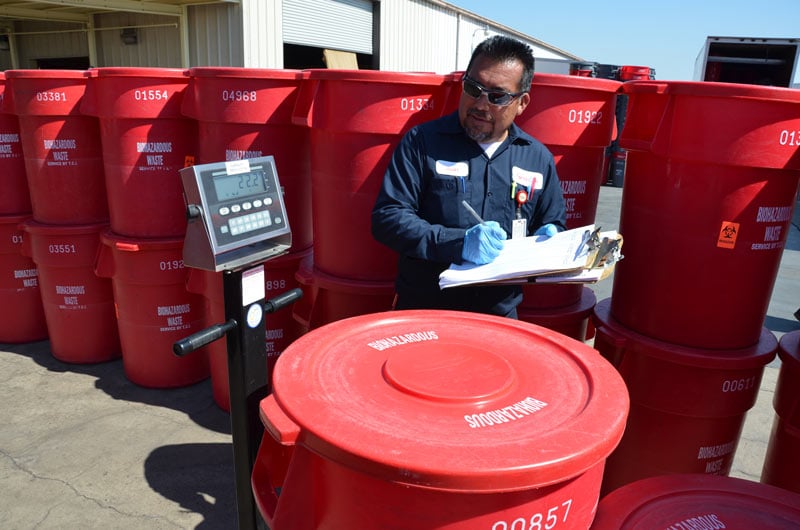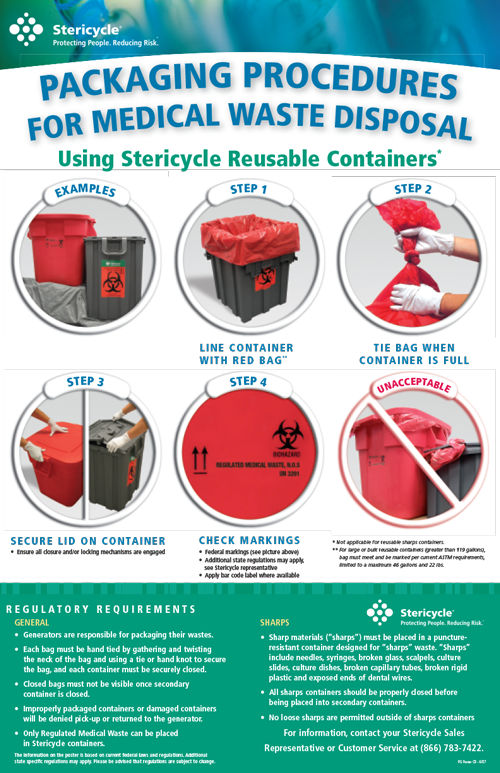Ideal Practices for Medical Waste Administration
Medical waste management is an important aspect of healthcare centers' operations to make sure the safety and security of people, staff, and the environment. Carrying out best techniques in medical waste management is vital to reduce the dangers connected with hazardous waste.
Segregation and Classification
In the area of clinical waste management, correct partition and categorization are essential practices for guaranteeing the safe and efficient disposal of healthcare-related products. Medical waste is created from numerous sources, consisting of hospitals, facilities, research laboratories, and various other healthcare centers. It contains a variety of things, such as needles, syringes, bandages, handwear covers, and pharmaceutical waste.
Segregation involves the methodical splitting up of different kinds of medical waste based upon their features and prospective threats. This process assists to avoid cross-contamination and makes sure that each type of waste is dealt with suitably. Sharps waste, such as blades and needles, ought to be placed in puncture-resistant containers to protect against injuries and the spread of transmittable diseases. Similarly, contagious waste, such as blood-soaked bandages or societies, should be segregated and treated independently to lessen the risk of spreading virus.
Classification is the process of classifying medical waste right into various groups based on its potential threats. WasteX Medical Waste Disposal. These groups may include contagious waste, dangerous waste, pharmaceutical waste, and basic waste. By categorizing waste, health care facilities can identify the suitable disposal approaches and ensure conformity with regional policies and standards
Correct segregation and classification of medical waste not just shield the health and wellness of healthcare employees and the public however additionally add to the general performance and performance of waste monitoring. It decreases the danger of accidents, lessens environmental influences, and promotes accountable waste disposal techniques.
Proper Storage Space and Identifying
To make sure the efficient and secure disposal of clinical waste, medical care centers should stick to proper storage space and labeling techniques. Correct storage and labeling play a vital role in preserving the stability of clinical waste management systems and shielding the health and wellness of health care workers, clients, and the public.
When it comes to storage, it is necessary to have assigned locations especially made for different kinds of medical waste. These areas must be safe, well-ventilated, and geared up with proper containers that satisfy regulative criteria. Segregation and categorization of waste need to also be considered to prevent cross-contamination and possible threats.
Furthermore, proper labeling is vital for effective waste administration. Each container should be clearly labeled with the ideal signs, color-coding, and information about the waste it has. Tags should consist of details such as the kind of waste, day of collection, and the name of the generator. This guarantees that all individuals handling the waste can quickly identify and handle it correctly.
Regular surveillance and evaluation of storage space areas and containers are essential to recognize any type of problems or violations. Personnel ought to be educated on proper storage space and labeling methods, emphasizing the value of conformity with guidelines and procedures.
Safe Transport and Handling
Making certain the correct and secure transport and handling of medical waste is vital for maintaining the integrity of waste administration systems and protecting the health and wellness of all included. Clinical waste, that includes products infected with infectious products, drugs, and other hazardous compounds, should be delivered in a way that avoids leakages, spills, and possible contamination.
To attain safe transportation and handling, several finest techniques need to be adhered to. Initially, it is important to utilize puncture-resistant and watertight containers that are particularly made for medical waste. These containers need to be effectively sealed and classified to stop any type of accidental direct exposure or messing up. Furthermore, waste must be set apart based upon its nature and kind to protect against cross-contamination.
During transportation, it look at here now is very important to guarantee that waste containers are safely secured and stored in a stable fashion. Cars utilized for delivering medical waste needs to be equipped with suitable safety and security features, such as spill control systems, to minimize the danger of any leakages or spills (medical waste removal service). Motorists should obtain training on correct handling and emergency reaction treatments to properly address any kind of unforeseen cases
Additionally, the transport and handling of clinical waste must follow all pertinent regulations and standards stated by local, state, and government authorities. Regular inspections and audits must be carried out to evaluate compliance and determine any type of areas for improvement.

Compliance With Regulatory Standards
Keeping conformity with regulative guidelines is essential for reliable medical waste management. These guidelines are implemented to safeguard public health and the setting by guaranteeing that medical waste is correctly handled, treated, and disposed of. medical waste disposal service. Conformity with regulative guidelines aids to stop the spread of contagious illness, reduce possible risks, and decrease the total influence of clinical waste on the setting
To accomplish compliance, healthcare facilities have to stay notified about the details policies controling medical waste monitoring in their territory. These laws might vary from nation to nation, and even within various states or areas. It is very important for healthcare facilities to have an extensive understanding of these standards and to execute proper techniques and methods to make sure conformity.
One key aspect of conformity is the proper partition and labeling of various sorts of clinical waste. This includes separating sharps from other waste, in addition to classifying waste based on its possible threats. Health care centers should additionally make certain that medical waste is kept in appropriate containers and that these containers are properly classified and sealed.
Additionally, compliance with regulatory guidelines calls for medical care facilities to establish appropriate training and education and learning programs for personnel associated with medical waste administration - WasteX Medical Waste Disposal. This consists of providing training on waste partition, taking care of, and disposal procedures, as well as the appropriate usage of personal safety tools
Regular monitoring and audits are likewise vital to guarantee ongoing conformity with regulatory guidelines. This entails conducting regular evaluations of waste storage space areas, recording waste administration treatments, and maintaining documents of waste disposal.
Effective Disposal Approaches
Medical care facilities need to utilize efficient disposal techniques for correct administration of medical waste - WasteX Medical Waste Disposal. Improper disposal of clinical waste can pose major health and wellness and ecological threats. There are numerous techniques that can be made use of to successfully get rid of clinical waste, making sure the safety of medical care employees, people, and the public
One typically used method is incineration. Incinerators can securely melt medical waste at heats, minimizing the quantity and damaging any potentially dangerous virus. Nonetheless, incineration can be pricey and may launch unsafe pollutants right into the air otherwise effectively regulated.
Another technique is autoclaving, which entails subjecting the waste to high-pressure steam. This process eliminates bacteria, viruses, and other microorganisms, rendering the waste safe for disposal in routine waste streams. Autoclaving is a environmentally friendly and effective method, however it calls for specialized devices and skilled employees.
Chemical disinfection is likewise made use of sometimes, where liquid chemicals are put on the waste to disinfect it. This technique is much less frequently used as a result of problems concerning the performance of chemical disinfection and the potential for chemical deposits to infect the setting.
In enhancement to these techniques, medical care facilities must also implement appropriate partition, packaging, and labeling of clinical waste to ensure its risk-free handling and disposal. Regular training and education and learning of personnel on appropriate waste administration methods are important to keeping effective disposal methods.
Conclusion

Clinical waste monitoring is an essential element of healthcare facilities' operations to make certain the safety of patients, staff, and the setting. Applying finest techniques in clinical waste management is important to lessen the threats connected with harmful waste. These classifications might consist of contagious waste, dangerous waste, pharmaceutical waste, and basic waste.In conclusion, carrying out finest practices for clinical waste management is essential for making sure the safety and security of healthcare workers, people, and the atmosphere. By correctly classifying and segregating waste, saving and classifying it properly, making certain secure transportation and handling, complying with governing guidelines, and employing reliable disposal techniques, health care centers can properly take care of and reduce the threats connected with clinical waste.